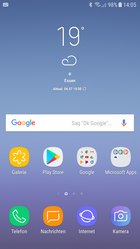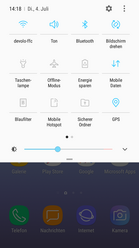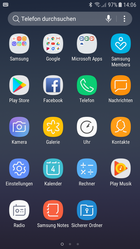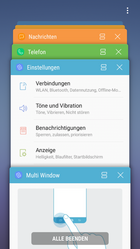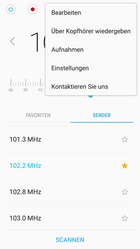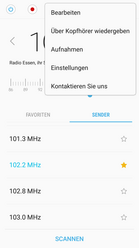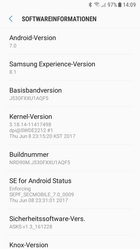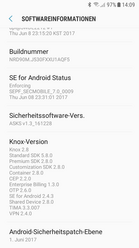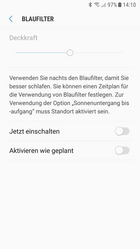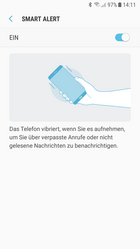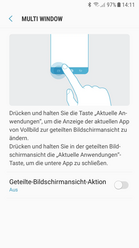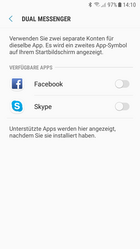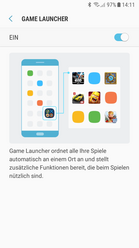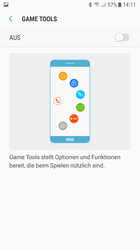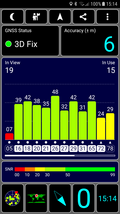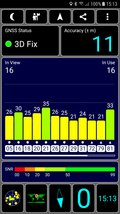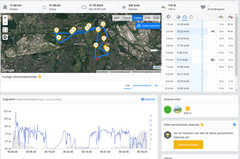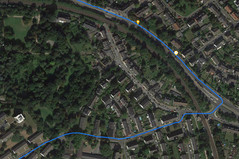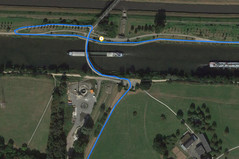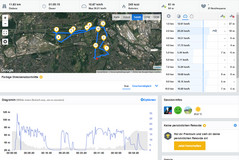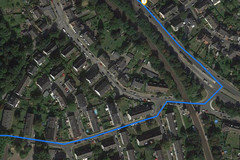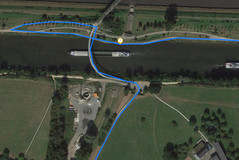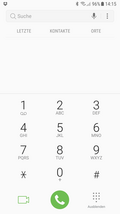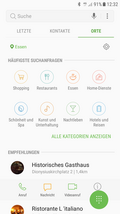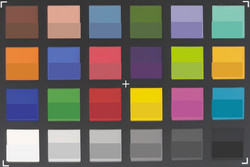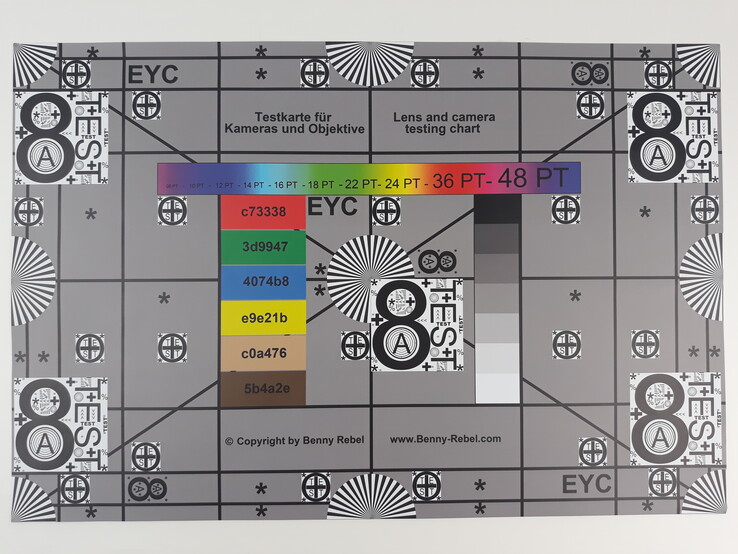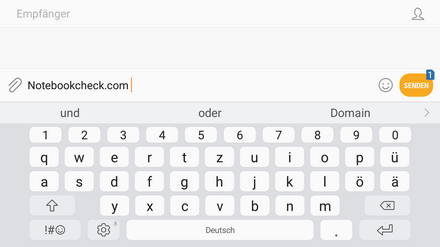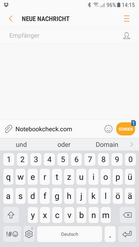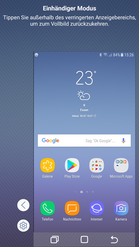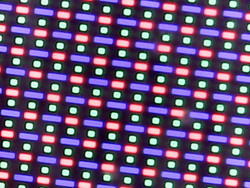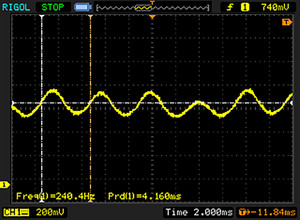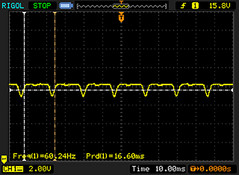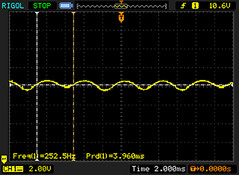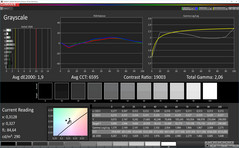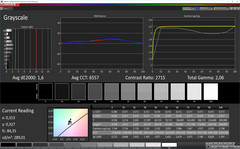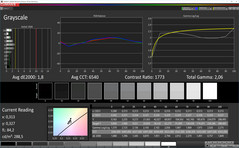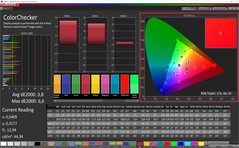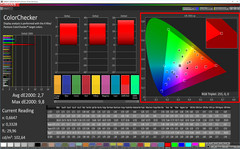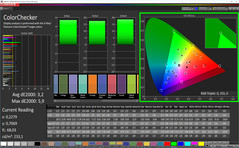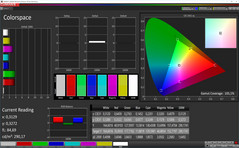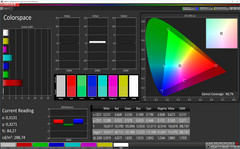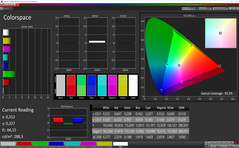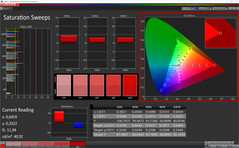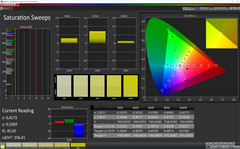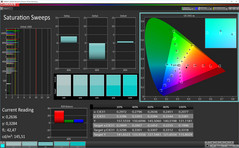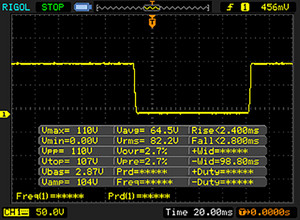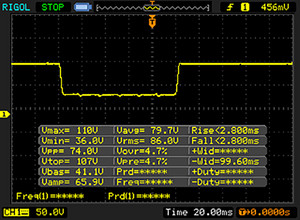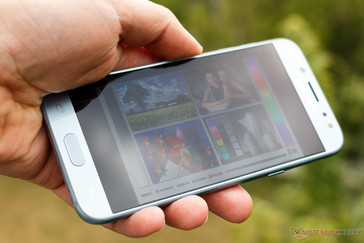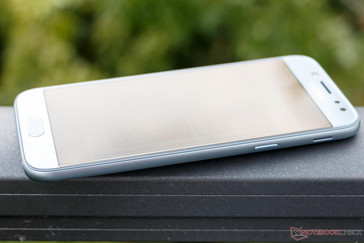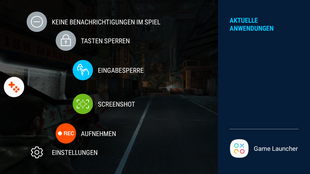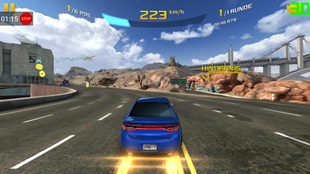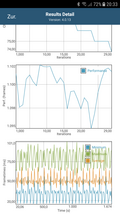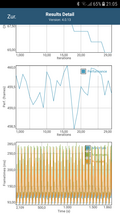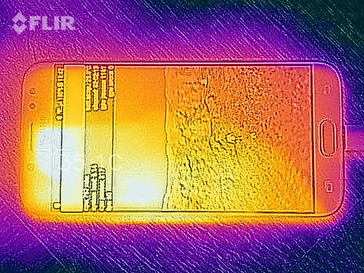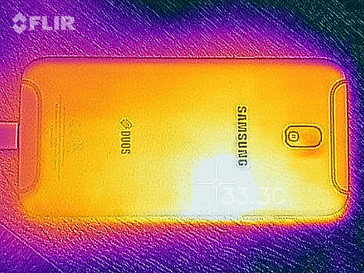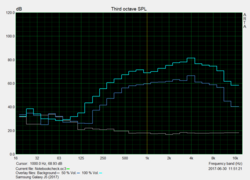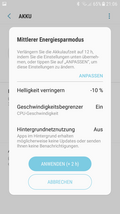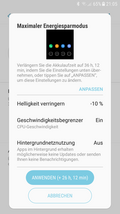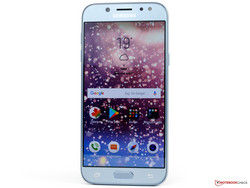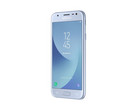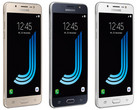Samsung Galaxy J5 (2017) Duos Smartphone Review
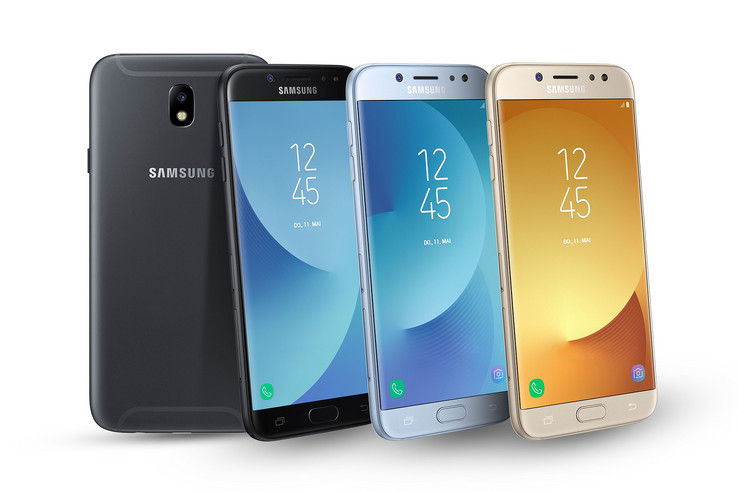
For the original German review, see here.
Compared to the predecessor, Samsung has implemented the most extensive changes in the design of the Galaxy J5 (2017) SM-J530F. While earlier, there was only an aluminum frame and the rest was poly-carbonate, the manufacturer has now decided to wrap the whole smartphone into aluminum. The battery is now built-in and even shrunk slightly. In addition, the Galaxy J5 finally has a surrounding-light sensor to control the display brightness. Instead of the Snapdragon, there is now an in-house Exynos processor inside. Samsung has also updated the cameras. The front camera offers a generous 13 megapixels and the main camera is nominally more light sensitive at f/1.7. Nothing has changed in terms of the storage equipment, though. Besides 2 GB of working memory, there are 16 GB of eMMC storage, which can be expanded via a microSD card. We have the Duos model which can accept two SIM cards in our test.
Positive: the recommended price remains unchanged at 279 Euros (~$315). Anyone with a little patience can save even more, since by now the J5 (2016) costs 100 Euros (~$113) less. Already one month after its release, the price has fallen to under 220 Euros (~$249) and since December it has continued to drop.
The competitors include the Huawei P10 Lite, the Lenovo Moto G5 Plus, the BQ Aquaris X5 Plus, the Sony Xperia XA1, and the BlackBerry DTEK50. By now, even the Apple iPhone SE is part of this price range and can offer a real alternative for fans of a small display.
Update 11/06/2017: A firmware update has been released. Details can be found in the software section.
Case
In the 2017 model, Samsung has completely redesigned the Galaxy J5, following more their A series. Although this looks good, it also makes the smartphone large, slightly growing it around all the edges. We like the fact that not only is the camera flush with the case, but even recessed slightly, which protects the glass from scratches. Samsung does not specify anything about the glass in the front, but where it transitions into the aluminum can be clearly seen. The antenna recesses fit excellently into the design.
Due to the aluminum body, the Samsung Galaxy J5 (2017) is very sturdy and can neither be twisted, nor does anything creak when trying. Even though the material changes are clearly apparent, it is cleanly built and the gaps are small and even. It is a bit unfortunate, that the card trays and their covers are made entirely from plastic, which may lead to a color change over time compared to the aluminum case, although originally the colors are identical.
The smaller card tray accepts a Nano-SIM card and the wider one, a second Nano-SIM as well as a microSD card. While the battery could still be removed in the Galaxy J5 (2016), it is built into the case and fixed in this model and cannot be replaced by the user. The smartphone is available in the colors black, gold, and blue.
Connectivity
The Samsung Galaxy J5 (2017) Duos has maintained its features that are almost unchanged in comparison to the predecessor. However, the SoC and LTE have become faster. The latter now supports one more band.
The bottom edge still provides a micro USB port. Samsung does not use the newer Type-C form factor in its entry-level series yet. This interface does not support video output, but OTG. Hence you cannot only connect external storage devices, but also peripherals. Unfortunately, the audio jack is also placed at the bottom edge. We would have wished it were on the top edge.
Our test model is the so-called Duos variant. This means that the smartphone can use two nano SIM cards simultaneously. It is a fully-fledged dual SIM variant, which also allows using a microSD card. The microSD slot supports the SDXC standard and therewith all usual storage media. Hence, it is possible to expand the storage capacity by up to 256 GB. However, it cannot be formatted as internal storage. Nevertheless, it is possible to move bigger apps to the optional microSD card.
Moreover, the Galaxy J5 supports Bluetooth 4.1, Ant+, Wi-Fi Direct and features an NFC chip as well as FM radio. A notification LED is not available.
Software
The Samsung Galaxy J5 (2017) uses Google Android 7.0 Nougat as operating system, which is skinned by the manufacturer's own TouchWiz UI. Among others, the Galaxy S8 also uses this UI. The software features are not restricted in any way. Apart from multitasking, the Game Tools and the Game Launcher are also available. The radio app appears very well-made to us. It starts an automatic channel search upon first launch and allows saving favorites, and recording channels. Moreover, several Microsoft apps are pre-installed, which cannot be completely uninstalled, but only deactivated.
The Android security patches are from 06-01-2017 and therewith up-to-date.
Update 11/06/2017: Samsung has started rolling out a new firmware, build NRD90M.J530FXXU1AQI3 (392 MB). In addition to stability improvements and bug fixes it is also supposed to contain new and enhanced features. However, we were unable to discover what exactly these were supposed to be. Google’s security patches have been updated to 08/01/2017.
Communication and GPS
The Samsung Galaxy J5 (2017) can connect to the mobile data network via HSPA+ or fast LTE Cat. 6, which allows download rates of up to 300 MBit/s on paper. Therewith, it is at least double as fast as its predecessor and supports the current standard of mobile network operators. The frequency coverage is also fully sufficient for Europe. Moreover, the Galaxy J5 supports Voice over LTE (VoLTE) and Wi-Fi telephony if this is also offered by the provider. Reception is okay, but connections sometimes dropped in the street in between houses, while other devices worked flawlessly there.
The Wi-Fi module of the smartphone supports the IEEE-802.11 standards a/b/g/n/ac and transmits in the 2.4 and 5.0 GHz frequency bands. The measurements with our reference router Linksys EA8500 showed very good and stable transfer rates. The range of the Wi-Fi is also very good. Even through an inside wall and in about 12 m (~39 ft) from the router, we still had a strong signal and could stream HD videos without problems.
| Networking | |
| iperf3 transmit AX12 | |
| Samsung Galaxy J5 (2017) Duos | |
| Huawei P10 Lite | |
| Sony Xperia XA1 | |
| Lenovo Moto G5 Plus | |
| iperf3 receive AX12 | |
| Samsung Galaxy J5 (2017) Duos | |
| Huawei P10 Lite | |
| Lenovo Moto G5 Plus | |
| Sony Xperia XA1 | |
The positioning of the Samsung Galaxy J5 (2017) is done via the satellite networks GPS, GLONASS, and BeiDou. The satellite fix is quite fast, but it is not particularly accurate at the beginning and it takes some time to reach an accuracy of about six meters (~20 ft). Inside the building, the positioning is less accurate, yet possible. Overall, the result is satisfactory.
We took the Galaxy J5 on a short outing and compared it to the bike computer Garmin Edge 500 in order to better evaluate its positioning accuracy. The total deviation of the whole bike tour is just 10 meters (~33 ft). Furthermore, the smartphone also performs very well and records the course relatively accurately at a closer look.
Telephone and Call Quality
The design of the telephony app is simple and clear. Hence, everyone should find their way around quickly. The tab places is a nice features and searches the area for amenities in order to directly show their contact data. This way, you can for example find the closest restaurant and book a table.
The call quality of the Samsung Galaxy J5 (2017) is not quite satisfactory. Voices sound dull on both sides. Furthermore, the voice of the J5 user is occasionally interrupted by small dropouts. Ambient noise suppression is missing. The situation gets even worse with speakerphone. Those who plan a long phone call had better not use it. While the included headset does also lack noise cancelling, it performs quite well otherwise.
Cameras
The front and the rear camera feature a resolution of 13 MP each. On paper, the camera above the display has improved a lot. With an f/1.9 aperture, its light sensitivity is relatively high. However it only features fixed focus. The recordings are quite decent under good light conditions as long as the subject does not move too fast. A LED can be used for brighter images in the dark.
The main camera has improved a lot and uses the same sensor from Sony, which is also used in the LG G6. An f/1.7 aperture suggests good light sensitivity. However, the relatively small pixels sized at 1.12 put this into perspective; even more so as the light sensitivity already reaches its maximum at ISO 1.250 (in manual mode ISO 800). LG has done a significantly better job in its flagship, but this belongs to an entirely different price category.
The shots of the Samsung Galaxy J5 are quite homogeneous in day light and deliver good results. In comparison to more expensive competitors, its dynamic range is quite limited. Thus bright parts could quickly get too bright. The smartphone compensates this by making the subject slightly darker, which shows in the comparison below. While the Galaxy collects much light and suppresses noise well under bad light conditions, contours and details get very blurry. As a result, shots already appear muddy at low magnification.
The J5 can record videos in Full HD (30 fps) at best. Due to the lack of image stabilization, the recordings blur quite easily and fast panning results in visible blurring.
We took a closer look at the camera of the Samsung Galaxy J5 (2017) under controlled light conditions. The X-Rite ColorChecker Passport shows quite a bright color reproduction. Only few colors such as orange and light green have a slightly higher saturation. The basic colors of blue, red, and green are slightly too pale. On the other hand, the J5 achieves a quite accurate white balance, which is only tends to be slightly warm.
The Galaxy J5 performs well in reproducing our test charts. At the center of the image all details are represented sharp and rich in detail. However, the sharpness falls relatively sharply towards the edges.
Accessories and Warranty
Samsung includes a 24-month warranty with the Galaxy J5 (2017) SM-J530F. Warranty is 12 months for the battery and 6 months for the accessories. Warranty extensions are not available. Please see our Guarantees, Return policies and Warranties FAQ for country-specific information.
The scope of delivery includes a modular power adapter rated at 7.75 watts (5 Volt, 1.55 Ampere), a USB cable, a headset and a small tool for opening the card slot. In addition, the package includes a small printed quick start guide and a few flyers with warranty information, security hints and regional restrictions.
Optional accessories were not offered in Samsung's shop at the time of testing.
Input Devices and Handling
The Samsung Galaxy J5 (2017) features a capacitive touchscreen, which can recognize and handle up to five simultaneous inputs. The gliding traits are very good and inputs are recognized quickly and reliably. Moreover, the display can be easily cleaned.
The variant known from the Galaxy S8 is used as default keyboard layout. It has a very clean design and also supports features such as swiping and automatic word suggestions. If you do not like it, you can install any layout from the Play Store.
The fingerprint sensor sits in the home button and appears to be very good. It proved to be responsive and reliable and upon unlocking the user gets direct access to the system without pressing the button even if the smartphone is in standby. The two sensor buttons beside the home button also react reliably. However, unfortunately, they are not lit. One-hand mode is kept simple, yet effective.
Display
The Super AMOLED display of the Samsung Galaxy J5 (2017) measures 5.2 inches and has a 1280x720 pixel resolution. Thus, it could be a little sharper, especially since most of the competitors in this price range already offer Full HD. On the other hand, there is finally an auto-brightness sensor which controls the brightness of the display. The maximum brightness can only be achieved with the sensor active. If the brightness is adjusted manually, we can only measure 300 cd/m² in the screen center. In the more relevant measurement with an even distribution of bright and dark areas (APL50) we were able to measure up to 546 cd/m².
Due to the Super AMOLED technology being used, each pixel is illuminated separately, which leads to a perfect black value. In theory, this results in a contrast ratio trending towards the infinite. Clouding or light halos are alien to this panel technology. For evenings, there is a blue-light filter which is supposed to be easy on the eyes in the dark.
| |||||||||||||||||||||||||
Brightness Distribution: 91 %
Center on Battery: 448 cd/m²
Contrast: ∞:1 (Black: 0 cd/m²)
ΔE ColorChecker Calman: 2.7 | ∀{0.5-29.43 Ø4.78}
ΔE Greyscale Calman: 1.6 | ∀{0.09-98 Ø5}
Gamma: 2.06
CCT: 6557 K
| Samsung Galaxy J5 (2017) Duos Super AMOLED, 1280x720, 5.2" | Samsung Galaxy J5 2016 AMOLED, 1280x720, 5.2" | Lenovo Moto G5 Plus IPS, 1920x1080, 5.2" | BQ Aquaris X5 Plus IPS, 1920x1080, 5" | Huawei P10 Lite IPS, 1920x1080, 5.2" | Sony Xperia XA1 IPS, 1280x720, 5" | BlackBerry DTEK50 IPS, 1920x1080, 5.2" | Apple iPhone SE IPS, 1136x640, 4" | |
|---|---|---|---|---|---|---|---|---|
| Screen | -34% | -71% | 8% | -55% | -57% | -23% | 20% | |
| Brightness middle (cd/m²) | 448 | 289 -35% | 503 12% | 640 43% | 507 13% | 522 17% | 535 19% | 603 35% |
| Brightness (cd/m²) | 451 | 291 -35% | 495 10% | 609 35% | 509 13% | 499 11% | 511 13% | 579 28% |
| Brightness Distribution (%) | 91 | 96 5% | 96 5% | 85 -7% | 95 4% | 92 1% | 89 -2% | 93 2% |
| Black Level * (cd/m²) | 0.31 | 0.93 | 0.36 | 0.74 | 0.89 | 0.88 | ||
| Colorchecker dE 2000 * | 2.7 | 4.7 -74% | 6.2 -130% | 2.8 -4% | 5.1 -89% | 4.2 -56% | 4.3 -59% | 1.8 33% |
| Colorchecker dE 2000 max. * | 9.8 | 7.3 26% | 9.8 -0% | 5.7 42% | 9 8% | 11.5 -17% | 8.2 16% | 3.5 64% |
| Greyscale dE 2000 * | 1.6 | 3 -88% | 6.8 -325% | 2.6 -63% | 6.1 -281% | 6.4 -300% | 3.6 -125% | 2.3 -44% |
| Gamma | 2.06 107% | 2.03 108% | 2.33 94% | 2.35 94% | 2.28 96% | 2.18 101% | 2.21 100% | 2.21 100% |
| CCT | 6557 99% | 6291 103% | 8113 80% | 6477 100% | 8143 80% | 7044 92% | 6352 102% | 6955 93% |
| Contrast (:1) | 1623 | 688 | 1408 | 705 | 601 | 685 | ||
| Color Space (Percent of AdobeRGB 1998) (%) | 62.13 | |||||||
| Color Space (Percent of sRGB) (%) | 96.74 |
* ... smaller is better
Screen Flickering / PWM (Pulse-Width Modulation)
| Screen flickering / PWM detected | 240.4 Hz | ||
The display backlight flickers at 240.4 Hz (worst case, e.g., utilizing PWM) . The frequency of 240.4 Hz is relatively low, so sensitive users will likely notice flickering and experience eyestrain at the stated brightness setting and below. In comparison: 53 % of all tested devices do not use PWM to dim the display. If PWM was detected, an average of 8111 (minimum: 5 - maximum: 343500) Hz was measured. | |||
OLED displays use PWM for brightness control. This is also true for the Samsung Galaxy J5 (2017). PWM is also present at maximum brightness. However, the amplitude variation is very small. The flickering first increases at 63% brightness and lower and hovers at 240 Hz. It remains relatively constant down to the minimum brightness of about 4 cd/m². The amplitude variation is also relatively small here. Hence, only sensitive persons should feel the effects of PWM.
Samsung's Super AMOLED displays shine with intensive colors and crisp contrasts. This also conforms to our subjective impression of the Galaxy J5 (2017). Nevertheless, we have examined the panel more closely with the photo spectrometer and the CalMAN analysis software. The colors are very accurate and are oriented towards the big AdobeRGB color space, which is not fully covered however. Almost all color deviations remains below a DeltaE of 4. Hence, they are almost invisible to the naked eye. Only red is different and is displayed very saturated.
Display Response Times
| ↔ Response Time Black to White | ||
|---|---|---|
| 5.2 ms ... rise ↗ and fall ↘ combined | ↗ 2.4 ms rise | |
| ↘ 2.8 ms fall | ||
| The screen shows very fast response rates in our tests and should be very well suited for fast-paced gaming. In comparison, all tested devices range from 0.1 (minimum) to 240 (maximum) ms. » 16 % of all devices are better. This means that the measured response time is better than the average of all tested devices (20.2 ms). | ||
| ↔ Response Time 50% Grey to 80% Grey | ||
| 5.6 ms ... rise ↗ and fall ↘ combined | ↗ 2.8 ms rise | |
| ↘ 2.8 ms fall | ||
| The screen shows very fast response rates in our tests and should be very well suited for fast-paced gaming. In comparison, all tested devices range from 0.165 (minimum) to 636 (maximum) ms. » 17 % of all devices are better. This means that the measured response time is better than the average of all tested devices (31.6 ms). | ||
The viewing angle stability of the Super AMOLED panel in the Samsung Galaxy J5 (2017) is good. Regardless of the angle, color inversions and ghosting effects cannot be observed. Only a slight brightness decrease is noticeable and the image gets a slight cyan haze. However, the latter is only noticeable in dark environments and is masked by reflections otherwise.
Performance
In the Samsung Galaxy J5 (2017) an Exynos 7870-SoC is used, just as in the Galaxy J7 (2016) or the Galaxy A3 (2017). The chipset has a processor with eight Cortex-A53 cores that each clock at up to 1.6 GHz and were manufactured in the 14 nm process. There are 2 GB of LPDDR3 working memory and 16 GB of internal storage. The graphics calculations are performed by an ARM Mali-T830 MP2.
The provided CPU performance is about on par with faster competitors. Within the comparison group, only the Moto G5 Plus (Snapdragon 625) performs slightly better. The smartphones from Lenovo and Huawei also perform better than our test model in system performance. In everyday life, these minor weaknesses are noticeable through short delays when switching between apps. Upday app in particular slows down the Galaxy J5.
In the graphics benchmarks, it quickly becomes apparent that the Samsung smartphone has very little reserves, since the manufacturer has incorporated the one core variant of the ARM Mali-T830. As the J5 only uses a 720p display, this is hardly noticeable in the onscreen tests.
| Geekbench 4.4 | |
| 64 Bit Single-Core Score (sort by value) | |
| Samsung Galaxy J5 (2017) Duos | |
| Samsung Galaxy J5 2016 | |
| Lenovo Moto G5 Plus | |
| Huawei P10 Lite | |
| Sony Xperia XA1 | |
| 64 Bit Multi-Core Score (sort by value) | |
| Samsung Galaxy J5 (2017) Duos | |
| Samsung Galaxy J5 2016 | |
| Lenovo Moto G5 Plus | |
| Huawei P10 Lite | |
| Sony Xperia XA1 | |
The Samsung Browser 5.4 is pre-installed for web surfing. Subjectively, it browses quite quickly through the World Wide Web. Only opening more complex web sites sometimes takes a little longer. In the benchmarks, the Samsung Galaxy J5 (2017) delivers very good results in the comparison field. It has to do with only a mid-range place in the Java benchmark JetStream.
* ... smaller is better
The Samsung Galaxy J5 (2017) features 16 GB of internal eMMC flash memory, 10 GB of which is available after the initial start. In view of the device category, the performance is alright, but most competitors perform slightly better in this respect. Smartphones from Lenovo in particular are significantly faster in reading and writing small data blocks.
We have checked the performance of the microSD card slot with our Toshiba Exceria Pro M401 reference card. While the potential of the card is not maxed out, the recorded performance is still good.
| Samsung Galaxy J5 (2017) Duos | Samsung Galaxy J5 2016 | Samsung Galaxy A3 2017 | Lenovo Moto G5 Plus | Huawei P10 Lite | Sony Xperia XA1 | BlackBerry DTEK50 | BQ Aquaris X5 Plus | Lenovo P2 | |
|---|---|---|---|---|---|---|---|---|---|
| AndroBench 3-5 | 5% | -1% | 160% | 70% | 73% | 2% | 18% | 89% | |
| Sequential Read 256KB (MB/s) | 204.4 | 147 -28% | 199.7 -2% | 233.4 14% | 264.3 29% | 248.5 22% | 226.6 11% | 228.4 12% | 270.1 32% |
| Sequential Write 256KB (MB/s) | 52 | 72 38% | 45.96 -12% | 132.5 155% | 129.2 148% | 127.8 146% | 72.8 40% | 47.03 -10% | 76.7 48% |
| Random Read 4KB (MB/s) | 24.07 | 21 -13% | 22.32 -7% | 68 183% | 72.5 201% | 66.2 175% | 15.76 -35% | 36.85 53% | 38.2 59% |
| Random Write 4KB (MB/s) | 9.9 | 11.6 17% | 9.62 -3% | 67 577% | 19.36 96% | 13.2 33% | 8.12 -18% | 12.44 26% | 44.4 348% |
| Sequential Read 256KB SDCard (MB/s) | 72.2 | 79.8 11% | 75.5 5% | 74.7 3% | 53.4 -26% | 78.4 9% | 74.1 3% | 73.2 1% | 79.3 10% |
| Sequential Write 256KB SDCard (MB/s) | 44.21 | 46.61 5% | 50.1 13% | 56.9 29% | 32.7 -26% | 68 54% | 48.87 11% | 54.9 24% | 59.4 34% |
Games
As already mentioned above, Samsung was a bit stingy in terms of GPU and has incorporated only a one core variant of the ARM Mali-T830. The graphics unit supports modern OpenGL ES 3.2 standard, but not the Vulkan API. Hence, gamers have to accept reducing the details in games. For example, the race game “Asphalt 8” runs smoothly at minimum details, but the Samsung Galaxy J5 (2017) only achieves an average of 22 fps at maximum details.
On a positive note, the Galaxy J5 also includes software features such as the Game Tools or the Game Launcher now, which were first introduced in the Galaxy S7. As the speaker sits on the sides, it cannot be covered and the sensors do not give rise to complaints. Furthermore, the J5 has pleasantly low power consumption during gaming.
| Asphalt 8: Airborne | |||
| Settings | Value | ||
| high | 22 fps | ||
| very low | 30 fps | ||
| Dead Trigger 2 | |||
| Settings | Value | ||
| high | 30 fps | ||
Emissions
Temperature
The surface temperatures of the Samsung Galaxy J5 (2017) are flawless and even under prolonged load, the phone does not even get lukewarm. It just reaches a maximum of 31.9 °C (~89 °F) in some places.
In addition, we checked the behavior of the SoC under load with the GFXBench battery test. The performance remains constant in the older T-Rex test (OpenGL ES 2.0) as well as in the more demanding Manhattan test (OpenGL ES 3.1).
(+) The maximum temperature on the upper side is 31.9 °C / 89 F, compared to the average of 35.2 °C / 95 F, ranging from 21.9 to 247 °C for the class Smartphone.
(+) The bottom heats up to a maximum of 30.4 °C / 87 F, compared to the average of 34 °C / 93 F
(+) In idle usage, the average temperature for the upper side is 29.6 °C / 85 F, compared to the device average of 32.9 °C / 91 F.
Speaker
Samsung has moved the mono speaker from the bottom edge to the side in the Galaxy J5 (2017). Hence, it is almost impossible to accidentally cover it. The component performs quite well at average volume and delivers a relatively decent sound. The mid tones in particular are accurate. At maximum volume, especially the medium highs distort. As a result, for example, sibilants appear very hard and sharp to the listener.
Subjectively, the audio jack of the smartphone appears good and transmits sound cleanly and with low noise. The included headset is very present in the lower middles and higher bass range. As a result, sound appears slightly muffled.
Samsung Galaxy J5 (2017) Duos audio analysis
(+) | speakers can play relatively loud (86.8 dB)
Bass 100 - 315 Hz
(-) | nearly no bass - on average 24.1% lower than median
(±) | linearity of bass is average (10.1% delta to prev. frequency)
Mids 400 - 2000 Hz
(+) | balanced mids - only 2.4% away from median
(+) | mids are linear (4.6% delta to prev. frequency)
Highs 2 - 16 kHz
(±) | higher highs - on average 6.2% higher than median
(+) | highs are linear (4.7% delta to prev. frequency)
Overall 100 - 16.000 Hz
(±) | linearity of overall sound is average (18.8% difference to median)
Compared to same class
» 22% of all tested devices in this class were better, 10% similar, 68% worse
» The best had a delta of 11%, average was 35%, worst was 134%
Compared to all devices tested
» 42% of all tested devices were better, 8% similar, 50% worse
» The best had a delta of 4%, average was 24%, worst was 134%
Huawei P10 Lite audio analysis
(+) | speakers can play relatively loud (85 dB)
Bass 100 - 315 Hz
(-) | nearly no bass - on average 27.2% lower than median
(±) | linearity of bass is average (10.3% delta to prev. frequency)
Mids 400 - 2000 Hz
(+) | balanced mids - only 4.6% away from median
(+) | mids are linear (5.1% delta to prev. frequency)
Highs 2 - 16 kHz
(±) | higher highs - on average 6.8% higher than median
(+) | highs are linear (5.2% delta to prev. frequency)
Overall 100 - 16.000 Hz
(±) | linearity of overall sound is average (23.4% difference to median)
Compared to same class
» 52% of all tested devices in this class were better, 8% similar, 40% worse
» The best had a delta of 11%, average was 35%, worst was 134%
Compared to all devices tested
» 69% of all tested devices were better, 6% similar, 25% worse
» The best had a delta of 4%, average was 24%, worst was 134%
Lenovo Moto G5 Plus audio analysis
(+) | speakers can play relatively loud (83.5 dB)
Bass 100 - 315 Hz
(-) | nearly no bass - on average 18% lower than median
(±) | linearity of bass is average (8.5% delta to prev. frequency)
Mids 400 - 2000 Hz
(±) | higher mids - on average 7% higher than median
(+) | mids are linear (6.2% delta to prev. frequency)
Highs 2 - 16 kHz
(+) | balanced highs - only 2.8% away from median
(+) | highs are linear (4.2% delta to prev. frequency)
Overall 100 - 16.000 Hz
(±) | linearity of overall sound is average (20.7% difference to median)
Compared to same class
» 36% of all tested devices in this class were better, 8% similar, 55% worse
» The best had a delta of 11%, average was 35%, worst was 134%
Compared to all devices tested
» 55% of all tested devices were better, 8% similar, 37% worse
» The best had a delta of 4%, average was 24%, worst was 134%
Frequency diagram in comparison (checkboxes can be selected/de-selected!)
Energy Management
Power Consumption
Even though compared to the predecessor (3100 mAh), the battery size of the Samsung Galaxy J5 (2017) has been reduced to 3000 mAh, the exemplary power consumption values point to an improved battery life. The measurements were taken with the highest manually adjustable panel brightness. If the auto-brightness sensor is allowed to increase the brightness to the maximum, the device uses 0.83 watts more power.
Although on paper, the Galaxy J5 does not support fast charging, the battery is recharged within 128 minutes, which is quite fast. Last year's model needed about 3 hours for a full charge. The 2017 variant of the J5 reaches 15% of the capacity in 15 minutes and 29% after half an hour. It takes 89 minutes to exceed the 80% level.
| Off / Standby | |
| Idle | |
| Load |
|
Key:
min: | |
| Samsung Galaxy J5 (2017) Duos 3000 mAh | Samsung Galaxy J5 2016 3100 mAh | Lenovo Moto G5 Plus 3000 mAh | Huawei P10 Lite 3000 mAh | Sony Xperia XA1 2300 mAh | BQ Aquaris X5 Plus 3200 mAh | BlackBerry DTEK50 2610 mAh | |
|---|---|---|---|---|---|---|---|
| Power Consumption | -24% | -68% | -57% | 0% | -92% | -96% | |
| Idle Minimum * (Watt) | 0.52 | 0.61 -17% | 0.91 -75% | 0.38 27% | 0.64 -23% | 0.87 -67% | 0.78 -50% |
| Idle Average * (Watt) | 1.17 | 1.41 -21% | 1.83 -56% | 1.87 -60% | 0.81 31% | 1.33 -14% | 1.72 -47% |
| Idle Maximum * (Watt) | 1.24 | 1.51 -22% | 1.87 -51% | 1.92 -55% | 0.86 31% | 1.35 -9% | 1.77 -43% |
| Load Average * (Watt) | 1.66 | 2.56 -54% | 3.17 -91% | 3.82 -130% | 2.09 -26% | 5.44 -228% | 4.33 -161% |
| Load Maximum * (Watt) | 2.94 | 3.1 -5% | 4.87 -66% | 4.9 -67% | 3.31 -13% | 7.11 -142% | 8.21 -179% |
* ... smaller is better
Battery Life
With 3000 mAh, the battery capacity of the Samsung Galaxy J5 (2017) might be slightly smaller than the model's from 2016. Nevertheless, all battery runtimes except for the Reader's test have improved. The tests at adjusted brightness (150 cd/m²) can be best compared. The Galaxy J5 also shows its strengths in this scenario and can almost unexceptionally outperform its competitors. Only the Moto G5 Plus lasts a few minutes longer in the Wi-Fi test.
The smartphone also proves to be very long-lasting under load. It might be the weak graphics unit, which makes extremely long battery runtimes possible. As we were slightly surprised, we monitored the values reported by the Stability test app, but the frame rates were as expected and the processor also worked consistently at 1.6 GHz. GameBench calculates a usage time of over 10 hours for the race game “Asphalt 8” and also the PCMark for Android Work 2.0 Battery test attest to the Galaxy J5’s excellent battery life of 12 hours and 48 minutes.
In addition, energy saving modes can be configured in order to extend the battery runtime.
| Samsung Galaxy J5 (2017) Duos 3000 mAh | Samsung Galaxy J5 2016 3100 mAh | Huawei P10 Lite 3000 mAh | Sony Xperia XA1 2300 mAh | BlackBerry DTEK50 2610 mAh | Lenovo Moto G5 Plus 3000 mAh | BQ Aquaris X5 Plus 3200 mAh | |
|---|---|---|---|---|---|---|---|
| Battery runtime | -13% | -23% | -19% | -44% | -16% | -32% | |
| Reader / Idle (h) | 26.1 | 26.7 2% | 23.5 -10% | 23.9 -8% | 17 -35% | 20.1 -23% | |
| H.264 (h) | 15.3 | 11 -28% | 9.8 -36% | 12.5 -18% | 7.9 -48% | 13.3 -13% | |
| WiFi v1.3 (h) | 12.3 | 10.7 -13% | 11.1 -10% | 11.3 -8% | 6.7 -46% | 12.4 1% | 8.4 -32% |
| Load (h) | 7.5 | 6.7 -11% | 4.8 -36% | 4.3 -43% | 4.1 -45% | 5.4 -28% |
Pros
Cons
Verdict
With the new edition of the Galaxy J5, Samsung has succeeded in creating a well-made new device of the upper entry-level class. Many smartphones will once again be compared to this smartphone this year. The Koreans have not focused on superlatives, but improved the core competences of the J5. Despite a slightly low resolution, the display convinces and is unrivaled in terms of color representation in its price class. On top of that, it convinces with high brightness and high contrast. Most important: Samsung has finally incorporated an ambient light sensor in the J5 - which has been long overdue.
The Samsung Galaxy J5 is not the smartphone with the largest memory, the best camera, or the fastest SoC in its price category, but it offers a consistent overall concept, which is convincing.
The cameras are not reference models, but they deliver good results if the environment is bright enough. The Wi-Fi module does not only support all current standards, but finally also delivers good transfer rates. However, the performance of the SoC could be higher. The GPU in particular is relatively weak. In this respect, competitors such as the P10 Lite or the Moto G5 Plus perform simply better. The internal storage of 16 GB is also rather standard fare. However, the storage capacity can be expanded with a microSD without forgoing the dual SIM feature.
The Samsung Galaxy J5 (2017) delivers excellent battery runtimes, which cannot often be reached even by smartphones with significantly higher battery capacities. The Samsung impressively demonstrates what it means to create an efficient product. However, customers will decide if Samsung was well-advised to also equip the J series with unremovable batteries.
Samsung Galaxy J5 (2017) Duos
- 07/05/2017 v6 (old)
Daniel Schmidt








